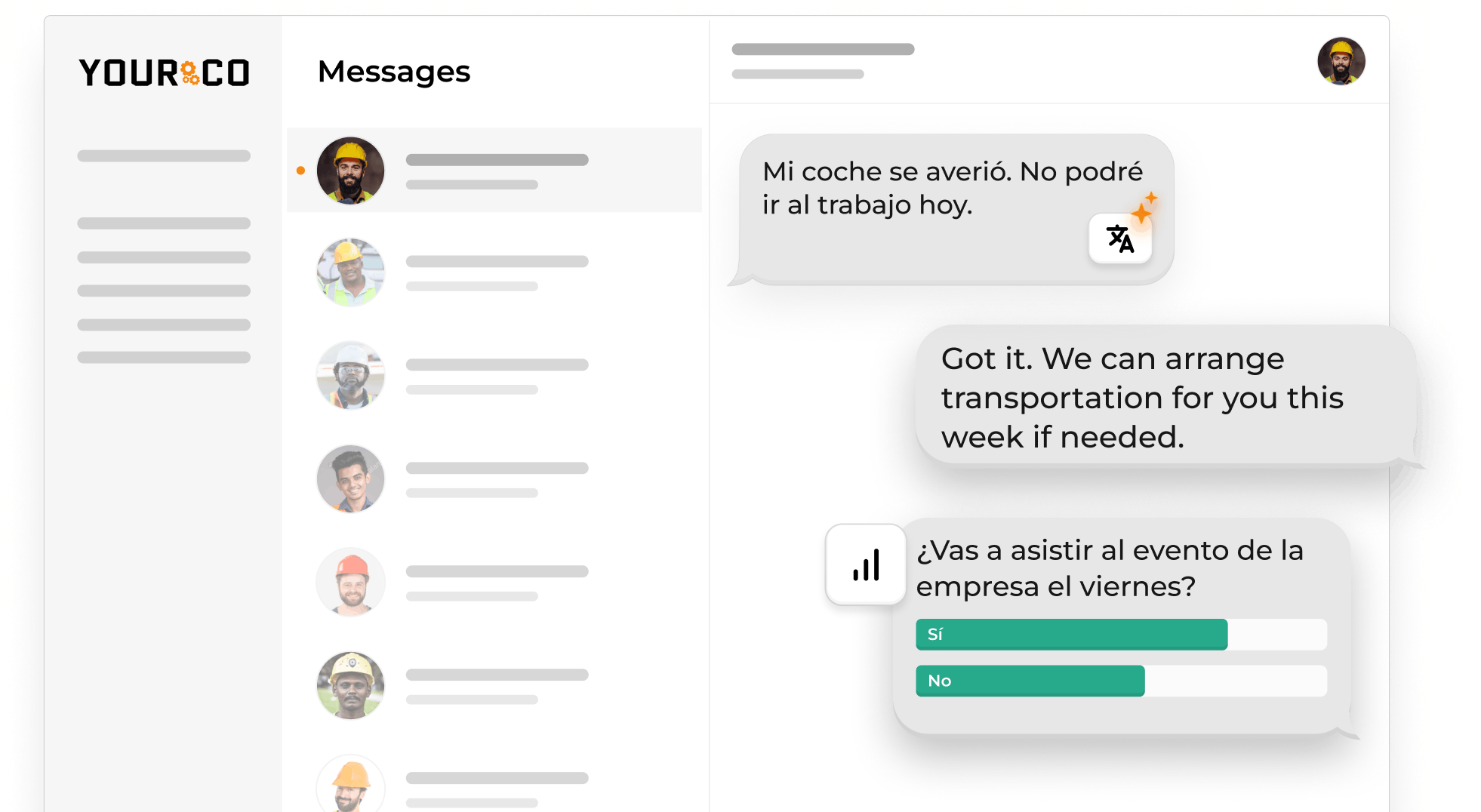How to Talk to an Employee About Excessive Absenteeism


Unplanned absences cost U.S. employers $225.8 billion every year. When employees miss shifts, you pay overtime to cover gaps, projects stall, and morale dips as reliable coworkers pick up the slack. Managing attendance well isn't just an HR task; it directly affects your wages, customer service, and team retention.
This guide provides a clear, step-by-step framework to tackle excessive absenteeism professionally and legally. You'll find practical scripts, documentation checklists, and long-term strategies that balance accountability with genuine support. Whether you oversee a small crew or multiple sites, these pages will help you navigate tough attendance conversations with confidence and consistency.
By the end, you'll know how to handle attendance problems as soon as they surface, spot patterns that signal deeper issues, prepare for difficult conversations without legal missteps, build targeted improvement plans that stick, and use simple technology to keep no-shows from sneaking up on you.
What Qualifies As Excessive Absenteeism?
Excessive absenteeism happens when an employee's absences exceed your attendance policy limits. Unlike an isolated sick day, excessive absenteeism shows up as a pattern. You might notice the same employee missing every other Friday. Or someone who clocks in late just often enough to avoid formal discipline.
These patterns often surface from two types of absences:
- Excused absences that follow company rules: scheduled time off, documented illness, jury duty.
- Unexcused absences that arrive without warning or proper documentation, leaving you scrambling to cover shifts.
When gray areas complicate things — a sudden migraine that later qualifies for FMLA, or car trouble followed by a vague doctor's note — consistent policies and tracking mechanisms will help you to identify patterns that need addressing. Weekly attendance reports help flag repeat patterns automatically. When you have clear data—dates, durations, employee responses—you walk into conversations with facts, not hunches. This approach gives you a clearer path to getting your whole crew back on track.
How to Start the Conversation Once You Notice a Pattern
A well-prepared manager keeps the discussion focused on facts, fairness, and support. Before you sit down with the employee, gather your documentation and review relevant policies and laws.
These steps might feel time-consuming, but they pay off with a conversation grounded in facts, guided by policy, and backed by complete records. That preparation creates a respectful tone and gives both you and the employee a clear path forward.
Reference Employee Attendance Records
Start by pulling complete attendance records: dates, durations, and any explanations the employee provided. Solid records protect everyone, so check them against prior warnings, daily communications, and time-clock data. Effective absence management requires keeping these details in one folder before the meeting. If the worker submitted doctor's notes or FMLA paperwork, place those next to your company attendance policy so you can reference both without digging through files during the conversation.
Review Company Policies & Legal Guidelines
Of course, we’re not legal professionals, but it may help to refresh your understanding of the Family and Medical Leave Act, the Americans with Disabilities Act, and any local paid-sick-leave rules that apply to your workplace. A quick review of ADP's comprehensive guide provides a useful overview. Your goal is straightforward: separate protected leave from unprotected no-shows so you don't discipline someone for a legally covered absence.
Create a Professional, Fair Environment
Set the stage for a respectful conversation by choosing a quiet, private space. Consider whether an impartial third party, like an HR partner, should join the discussion. Having a witness protects both you and the employee, ensures consistency in how you handle similar situations, and provides an extra set of ears to catch important details.
A structured, empathetic conversation shows the employee you're genuinely interested in understanding their perspective, not just delivering discipline. Prepare by writing down three or four open-ended questions like "Can you walk me through what's been happening on Monday mornings?" These questions invite context rather than defensiveness. It also gives the employee a fair shot at fixing attendance issues.
Step-by-Step Conversation Framework
With the facts in hand, walk through this ten-step framework.
Step 1: Open with warmth. Start with a friendly greeting that sets a collaborative tone.
Sample: "Thanks for meeting with me, Jordan. I appreciate your time today."
Step 2: State the policy. Briefly remind the employee of the attendance standards they agreed to when they signed the handbook. Keep this explanation short to avoid sounding punitive.
Sample: "Our policy explains how to call in sick before a shift, in accordance with common workplace attendance procedures. The specific allowance for unexcused absences may vary by organization."
Step 3: Present the facts. Share specific dates, times, and any prior warnings. Stick to data, not judgments. Factual documentation protects both you and the employee.
Sample: "In March, you missed five shifts without prior notice: March 3, 7, 14, 21, and 28."
Step 4: Show concern, invite context. Shift from facts to empathy and ask an open question. Open-ended questions promote honesty and help you understand what's really happening.
Sample: "Can you share what's been going on that made it hard to come in?"
Step 5: Listen actively and explore accommodations. Paraphrase what you hear, ask clarifying questions, and consider whether FMLA or ADA might apply. Pausing discipline to gather medical documentation may be the safest route if a disability is mentioned.
Sample: "It sounds like you're caring for your father after surgery. Would information on family-leave options help?"
Step 6: Explain team and financial impact. Connect the absences to real consequences—missed deadlines, overtime wages, and strain on co-workers. Clear impact statements help employees understand why attendance matters.
Sample: "Your last-minute absences mean other team members need to work late. If you’re going to be out, we need to find a replacement immediately to cover your station."
Step 7: Set clear expectations. Revisit the policy and outline acceptable attendance moving forward. Avoid fuzzy language.
Sample: "Starting today, we expect you to text for last-minute call-offs and submit follow-up documentation, such as a doctor’s note. Do you think this is a fair expectation?"
Step 8: Agree on measurable goals. Work together on a concrete target and follow-up date.
Sample: "Let's aim for perfect attendance through the next schedule cycle. We'll check in on May 1."
Step 9: Outline next steps and potential consequences. Transparent consequences satisfy legal requirements because they're documented and evenly applied.
Sample: "If another unexcused absence occurs, the next step is a written warning per policy."
Step 10: Document immediately. Include the discussion, both parties' comments, and the agreed action plan. Send a copy to HR for the personnel file. Consistent documentation may help protect you if the employee later claims unfair treatment.
Before ending the meeting, recap action items aloud and ask the employee to confirm understanding. Offer support resources such as EAP or flexible scheduling if appropriate, then thank them for their honesty.
How to Handle Tough Scenarios
Even a well-planned conversation can veer off track. Here's how to stay calm and compliant in three common situations.
When an employee gets defensive and voices rise, pause the meeting and restate the facts in a neutral tone. Consider bringing HR to a rescheduled session if emotions remain high. You might say, "I understand you're frustrated. Let's take a ten-minute break and revisit the dates together." This approach de-escalates tension while keeping the focus on documented facts rather than personal feelings.
If an employee discloses a new medical condition during the conversation, immediately stop any disciplinary discussion and provide FMLA or ADA forms. Shift into an interactive process rather than issuing warnings, as legal requirements now apply. A simple response like, "Thank you for sharing that diagnosis. Let's get you the paperwork so we can explore leave options," shows you're taking their disclosure seriously.
When an employee denies there's an attendance pattern, show them an attendance chart and invite their interpretation. Visual data often reduces arguments and helps employees see the bigger picture. Try saying, "Here's a calendar of your absences. Help me understand what you see and where we might improve." This collaborative approach encourages problem-solving instead of defensiveness.
Throughout each scenario, stick to need-to-know medical details only. Over-sharing can breach confidentiality and damage trust. By following the framework and applying policies consistently, you give both the employee and your team the best chance to turn attendance around.
Address Root Causes & Offer Support
Of course, you can't fix absenteeism by scolding attendance numbers alone. Lasting progress comes from uncovering why people stay home and giving them real ways to come back.
Every team faces different challenges, but certain patterns appear consistently across workplaces. Workers dealing with ongoing illness or injury often struggle with physically demanding roles. Mental health issues and burnout create even bigger gaps. Research shows that employees with poor mental health miss about four times more unscheduled days than their peers, a difference that exceeds most physical conditions. Childcare and eldercare responsibilities become especially difficult when rigid schedules clash with emergencies like a sick child or closed daycare.
Poor leadership plays a major role too. When managers fail to provide feedback or recognition, engagement drops and attendance follows. Workplace harassment or safety concerns make employees avoid coming to work. Sometimes it's simple disengagement. When the job feels thankless, showing up becomes less of a priority.
Once you identify which issues drive an employee's absences, match them with targeted support:
- Employee Assistance Programs can connect staff to counseling within days, helping with both mental health and caregiving stress
- Flexible scheduling options like shift swaps, adjusted start times, or compressed workweeks let workers handle appointments without calling out last minute
- Harassment investigations should be prompt and confidential, making it clear retaliation won't be tolerated
- Engagement improvements through regular recognition, clearer goals, and chances to learn new skills often restore commitment
Confidentiality remains critical while exploring solutions. Health details belong on a strict need-to-know basis, and ADA guidelines generally require a private, interactive process before denying accommodation requests.
To surface early warning signs before absences spike, send quick, anonymous pulse polls via text. Because their phone is constantly in their pocket, employees are more likely to see the message, and you’re more likely to get real-time data on workload, stress, or safety concerns that might otherwise stay hidden.
Craft an Attendance Improvement Plan & Follow Up
A clear, documented plan turns a vague "try to be here more" into measurable action that protects you legally and gives the employee a fair path back to reliable attendance.
Start by framing the goal with the SMART method—Specific, Measurable, Achievable, Relevant, and Time-bound. For attendance, that usually means agreeing on an exact number of allowable absences or tardies within a set period and scheduling check-ins to confirm progress.
An improvement plan can be as simple as the template below. Keep it factual, use data pulled from your time-clock system, and attach any previous warnings or FMLA/ADA paperwork so you can separate protected leave from policy breaches.
30-Day Improvement Plan Template
[Employee Name] 30-Day Plan
Current attendance record: [List the number of absences and time frame, e.g., “7 unexcused absences since May 1]
Improvement target: [Outline their goal, e.g., “No more than 1 unexcused absence in the next 30 days”]
Progress check dates: [The dates you will check-in with the employee, e.g., “June 15 and June 30”]
Support offered: [List any options the company offers, e.g. “Flexible start time, EAP brochure, ride-share vouchers”]
Consequences if not met: [Explain the process if they don’t meet expectations, up to termination, “e.g., Written warning. If not met, you may be terminated.”
Employee Signature: [Have the employee sign and date the document]
Send the employee a copy of the agreement and stick to the plan. Document any steps taken by the parties involved. Keep each note objective—dates, times, facts—so anyone reviewing the file sees a clear, fair process. If improvement targets are met, acknowledge the win and close the plan in writing. If they're missed, escalate exactly as your policy states. Wavering here undermines credibility and can expose you to claims of uneven enforcement. Consistency, not surprise, drives real change and keeps the process defensible.
Stay Ahead of Attendance Challenges With Yourco
The fastest way to cut absenteeism is simple: reach every worker before their shift starts, confirm they're coming, and capture that record automatically. Yourco makes this process effortless with plain-text SMS that works on any phone—no apps, logins, or Wi-Fi required.
You create the schedule once, then Yourco sends timed SMS reminders with a simple "YES" or "NO" reply prompt. When an employee texts back, the system stamps the response, updates the roster, and alerts you if a shift is suddenly empty. Every message gets stored in automated logs, giving you an audit trail for wage disputes or compliance checks. Need to tweak a start time or add overtime? One text updates the entire crew in real time, and AI-powered translations cover more than 130 languages so nothing gets lost.
Clear absence policies remain essential for accountability. While SMS makes last-minute call-offs easier for employees, your policies should still require appropriate follow-up documentation, such as a doctor's note for illness-related absences. This balance ensures the system supports legitimate needs without encouraging unnecessary last-minute absences or policy abuse.
Unlike generic texting apps, Yourco auto-logs messages, tracks confirmations, and highlights patterns—who's chronically late, which shifts trigger the most absences—so you can tackle root causes early.
Try Yourco for free today or schedule a demo and see the difference the right workplace communication solution can make in your company.
Frequently Asked Questions
How do I manage employees with chronic health issues while maintaining attendance standards?
Start with empathy and understanding. If you notice an absence pattern that might indicate a serious health condition, pause any disciplinary action and consider whether the time off could be protected under FMLA or ADA. Offer reasonable accommodations like flexible start times or modified schedules, and document every conversation. You can still maintain clear expectations by creating a written improvement plan that outlines required notice for future absences. Since poor mental health causes three times more unplanned absences than physical illness, connect employees to your EAP or wellness resources when appropriate.
What are the legal guardrails for addressing suspected sick-leave abuse?
We’re not legal professionals, so it’s always best to consult your company’s policy and general counsel. That said, best practices suggest checking state and federal sick-leave laws. Then document each absence with the reason given and notice provided. If patterns look suspicious—like every Friday absence—you can ask for written certification as allowed by your policy, but avoid asking for specific medical details.
How should I handle absenteeism spikes around holidays and weekends?
Track your data by day of the week to spot patterns early. Post schedules well in advance, send SMS shift reminders 24 hours before shifts, and offer voluntary overtime or shift swaps to cover expected gaps. Clear policies about blackout dates help, but pair them with fair rotation so the same people aren't always stuck working holidays. Time-tracking data will show you if your approach is working and help identify time theft patterns.
Could high absenteeism be indicating broader cultural issues in my organization?
High absence rates often point to burnout, disengagement, or poor management. Look beyond individual problems and survey your team via SMS about workload, leadership support, and workplace safety. High absence rates clustered around one supervisor or location usually signal leadership or culture problems, not just personal issues.




